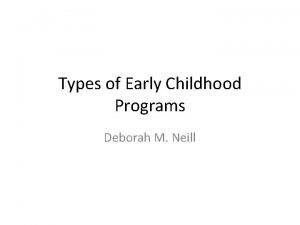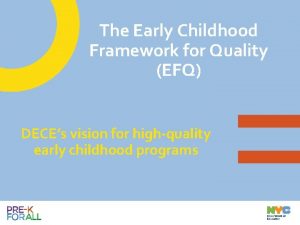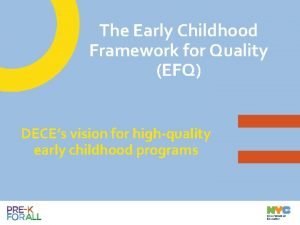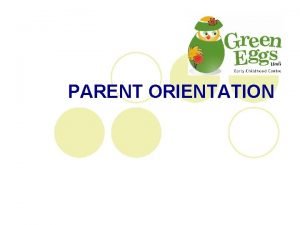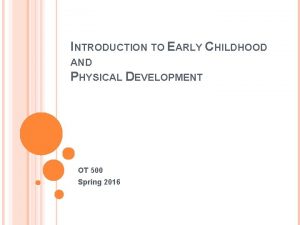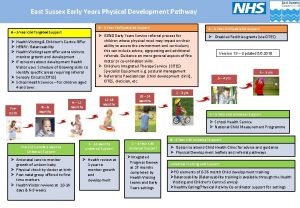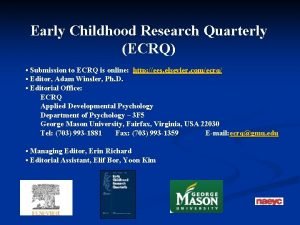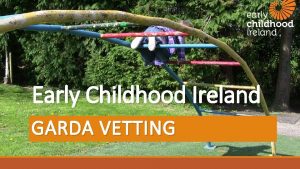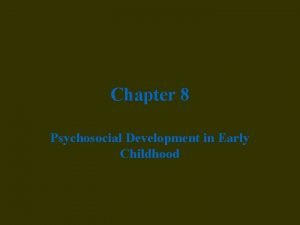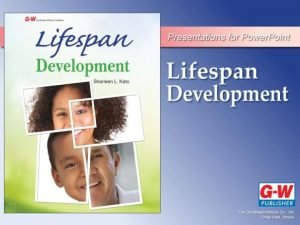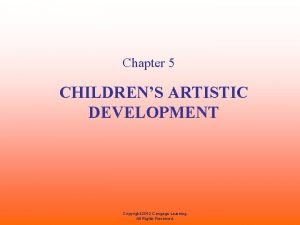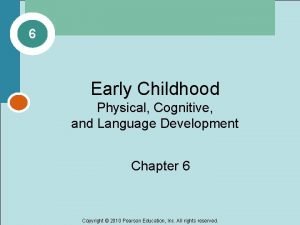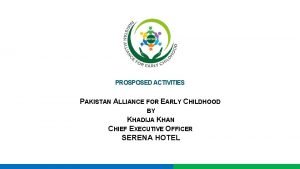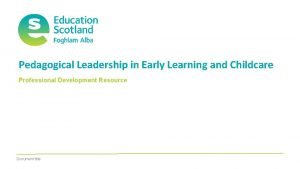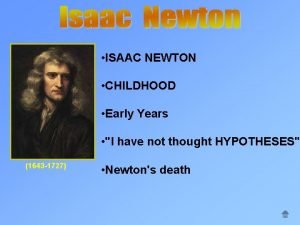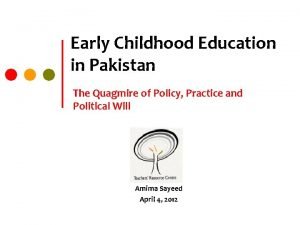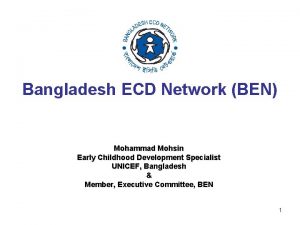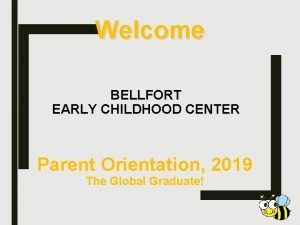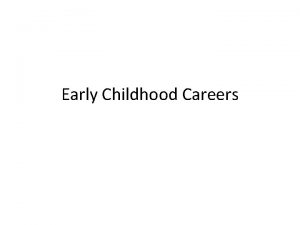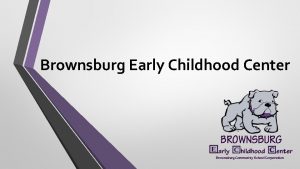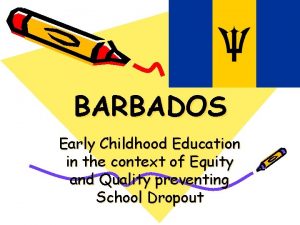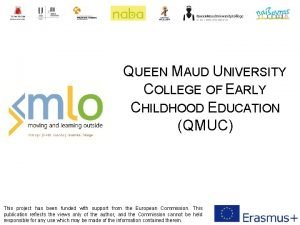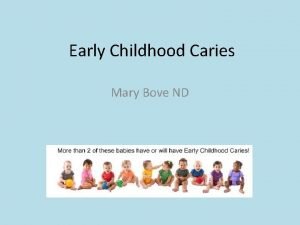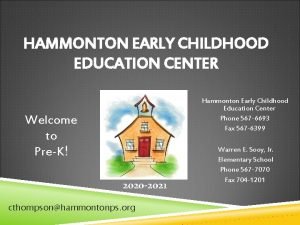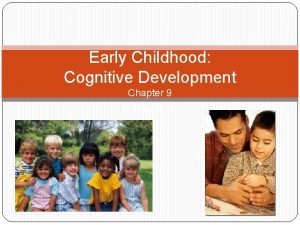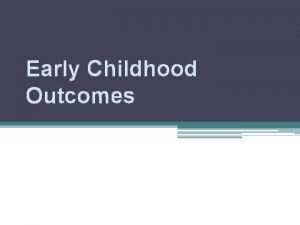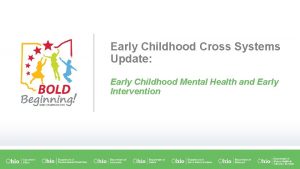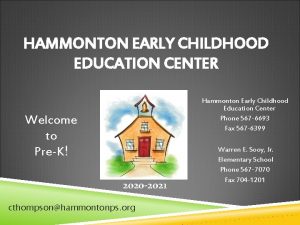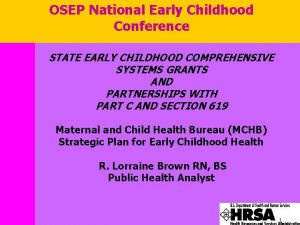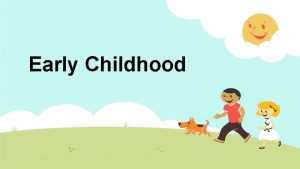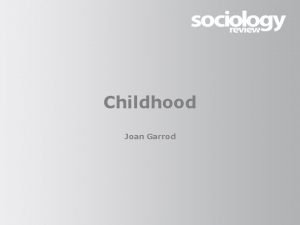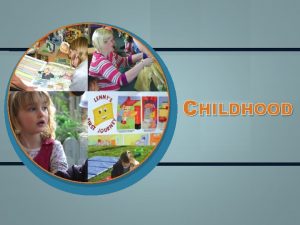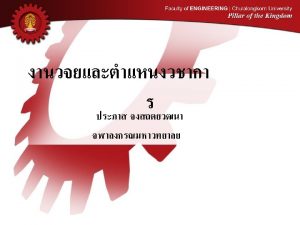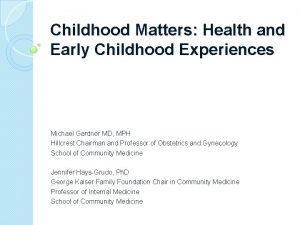WHAT WILL YOU KNOW Thinking During Early Childhood
































- Slides: 32


WHAT WILL YOU KNOW? Thinking During Early Childhood Language Learning Early-Childhood Schooling

Thinking During Early Childhood Piaget: Preoperational intelligence • Occurs between the ages of about 2 and 6 • Suggests thinking occurs in symbols, not just via senses and motor skills (symbolic thought) • Includes language, imagination, animism

Piaget: Preoperational Thought Four limitations of preoperational thought that make logic difficult until about age 6. Centration • Includes characteristic of preoperational thought whereby a young child focuses (centers) on one idea, excluding all others; may include egocentrism Focus on appearance • Characteristic of preoperational thought whereby a young child ignores all attributes that are not apparent

Piaget: Preoperational Thought Static reasoning • Characteristic of preoperational thought whereby a young child thinks that nothing changes. Whatever is now has always been and always will be. Irreversibility • Characteristic of preoperational thought whereby a young child thinks that nothing can be undone. A thing cannot be restored to the way it was before a change occurred.

Piaget: Preoperational Thought All four characteristics of preoperational thought are evident in classic conservation task errors. Young children fail to understand conservation of liquids because they focus (center) on what they see (appearance) noticing only the immediate (static) condition. It does not occur to them that they could reverse the process and re-create the liquid’s level of a moment earlier (irreversibility).

Piaget: Preoperational Thought Conservation WORTH PUBLISHERS – Principle that the amount of a substance remains the same (i. e. , is conserved) when its appearance changes. Demonstration of Conservation. Sarah, here at age 5. , demonstrates Piaget's conservation-of-liquids experiment.

Types of Conservation Volume Number Matter Length

Piaget: Preoperational Thought Limitations of Piaget’s research • Piagetian conservation tasks require words. • Modification of tasks resulted in better performance of younger children. • Piaget underestimated cognition during early childhood.

Vygotsky: Social Learning Vygotsky: Social learning • Every aspect of children's cognitive development is embedded in the social context. Apprentice in thinking • Someone whose intellectual growth is stimulated and directed by older and more skilled members of society Mentors • • Present challenges Offer assistance (without taking over) Add crucial information Encourage motivation

Vygotsky: Social Learning Guided participation Zone of proximal development (ZPD) • Skills that a person can exercise only with assistance, not yet independently CORBIS RF/AGE FOTOSTOCK • Process by which people learn from others who guide their experiences and explorations Words Fail Me Could you describe how to tie shoes?

Vygotsky: Social Learning Scaffolding TIM HALL/GETTY IMAGES • Temporary support that is tailored to a learner's needs and abilities and aimed at helping the learner master the next task in a given learning process. • A large, attractive abacus could be a scaffold. However in this toy store, the position of the balls suggests that no mentor is nearby. • Children are unlikely to grasp the number system without a motivating guide.

Vygotsky: Social Learning Overimitation • Tendency of children to copy an action that is not a relevant part of the behavior to be learned • Common among 2 - to 6 -year-olds when they imitate adult actions that are irrelevant and inefficient

Vygotsky: Language As a Tool Words are the mediator between brain potential and comprehension. Language advances thinking • Internal dialogue or private speech • Social mediation STEM learning (science, technology, engineering, math) • • Practical use of Vygotsky’s theory Examples: Math learning

Vygotsky: Language As a Tool Words enable many children between 2 and 6 to learn math. • • Using one-to-one correspondence Remembering time and dates Understanding sequence Knowing what numbers are higher than others

Children’s Theories Theory-theory • Children attempt to explain everything they see and hear. • Theories do not appear randomly. • Children develop theories about intentions before they employ their impressive ability to imitate.

Children’s Theories WORTH PUBLISHERS Theory of mind Candies in the Crayon Box Any one would expect crayons in a crayon box, but once a child sees that candy is inside, he expects that everyone else will also know that candies are inside! • Involves person's theory of what other people might be thinking • Is slow to develop but typically beginning in most children at about age 4 • Can be seen when young children try to escape punishment by lying

Brain and Context What strengthens theory of mind in young children? • Child's ability to develop theories correlates with the maturity of the prefrontal cortex and with advances in executive processing. • Context and experience are relevant. • Context and culture matter.

Language Learning Language is pivotal to every kind of cognition in early childhood. • Early childhood is a sensitive period or best time to master vocabulary, grammar, and pronunciation. • The average child knows about 100 -2000 words at age 2 and more than 5000 to 30000 at age 6.

Language Learning Vocabulary explosion • Vocabulary builds quickly and comprehension is greater than production. • Verbs, adjectives, adverbs, conjunctions, and many nouns are mastered. Fast-mapping • Speedy and sometimes imprecise way in which children learn new words by tentatively placing them in mental categories according to their perceived meaning

Words and the Limits of Logical extension • Closely related to fast-mapping • Occurs when children use word to describe other objects in same category • Bilingual children often use codeswitching.

Language Learning Grammar of a language • Structures, techniques, and rules that communicate meaning • Word order and word repetition, prefixes and suffixes, intonation and emphasis Overregularization • Application of rules of grammar even when exceptions occur • Makes language seem more “regular" than it actually is Pragmatics • Practical use of language that includes the ability to adjust language communication according to audience and context

Learning Two Languages Language-minority children • Lower school achievement, diminished selfesteem, and inadequate employment • Both languages sited in the same areas of their brains • Adult second language learners usually show different activation sites for each language and are slowed down.

Language Losses and Gains Language shifts • Becoming more fluent in the school language than in their home language Balanced bilingual • Being fluent in two languages, not favoring one over the other • Occurs if adults talk frequently, listen carefully, and value both languages

Strategies and Experiences to Support Literacy Learning • • • Code-focused teaching Book reading Parent education Language enhancement Preschool programs

Early Childhood Education Homes and schools • Quality matters. • If the home educational environment is poor, a good preschool program aids health, cognition, and social skills. • If a family provides extensive learning opportunities and encouragement, the quality of the preschool is less crucial.

Early Childhood Education Child-centered programs • Stress children's natural inclination to learn through play rather than by following adult directions. • Encourage self-paced exploration and artistic expression. • Show the influence of Vygotsky, who thought that children learn through play with other children and through cultural practices that structure life.

Early Childhood Education • Montessori schools emphasize individual pride and accomplishment, presenting literacy-related tasks (such as outlining letters and looking at books). • Reggio Emilia Named after the town in Italy where it began. Children are encouraged to master skills such as writing and using tools (hammers, knives, and so on) ELIZABETH FLORES KRT/NEWSCOM Child-centered programs

Early Childhood Education Teacher-directed programs • Stress academic subjects taught by a teacher to an entire class • Help children learn letters, numbers, shapes, and colors, as well as how to listen to the teacher and sit quietly • Make a clear distinction between work and play • Are much less expensive, since the child/adult ratio can be higher

Comparing Child-Centered and Teacher. Directed Most child-centered programs • Advocate child-centered programs • Believe learning comes from within • Resist legislative standards and academic tests • Argue social skills and creative play are essential Most teacher-directed programs • Instruct, rather than facilitate learning • Are more consistent in beliefs and behaviors • Are often influenced by parents who want academic skills and respect for authority to be taught

Early Childhood Education Intervention programs: Head Start • Most widespread earlychildhood education program in the United States • Improved literacy and math skills, oral health and parental responsiveness during early childhood. © JIM WEST/ALAMY • Begun in 1965 and funded by the federal government

Long-Term Gains from Intensive Programs Early intervention is effective if it is sufficiently intense and involves effective teachers. Evidence • Perry(High/Scope) • Abecedarian • Child-Parent Centers
 Principles of growth and development
Principles of growth and development Thinking about you thinking about me
Thinking about you thinking about me Three types of early childhood programs
Three types of early childhood programs Types of early childhood programs activity a chapter 2
Types of early childhood programs activity a chapter 2 Efq nyc doe
Efq nyc doe Early childhood framework for quality
Early childhood framework for quality Professional development program rockefeller college
Professional development program rockefeller college Green eggs early childhood centre
Green eggs early childhood centre Early childhood directorate
Early childhood directorate Leonardo da vinci's childhood
Leonardo da vinci's childhood Fine motor skills development in early childhood
Fine motor skills development in early childhood Trends in early childhood education
Trends in early childhood education Physical development in early childhood
Physical development in early childhood Early childhood research quarterly
Early childhood research quarterly Early childhood ireland garda vetting
Early childhood ireland garda vetting Psychosocial development in early childhood
Psychosocial development in early childhood Chapter 7 early childhood ages 3 through 5
Chapter 7 early childhood ages 3 through 5 Kellogg's developmental stages of art
Kellogg's developmental stages of art Amelia earhart's childhood
Amelia earhart's childhood Language development in early childhood
Language development in early childhood Pakistan alliance for early childhood
Pakistan alliance for early childhood Pedagogical leadership skills
Pedagogical leadership skills Isaac newton early childhood
Isaac newton early childhood Eminem early childhood
Eminem early childhood Ece in pakistan
Ece in pakistan Chapter 9 early childhood cognitive development
Chapter 9 early childhood cognitive development Early childhood education in bangladesh
Early childhood education in bangladesh Bellfort early childhood center
Bellfort early childhood center Associates in early childhood education jobs
Associates in early childhood education jobs Biosocial development in early childhood
Biosocial development in early childhood Brownsburg early childhood center
Brownsburg early childhood center Attainment targets barbados
Attainment targets barbados Queen's university early childhood education
Queen's university early childhood education


